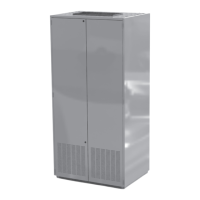www.changeair.com
20
Sophomore Series 4000 & 5000 Cabinet - Classroom Air Handler - Owner's Manual - Installation, Operation, and Service Instructions
5. If the wall is not perfectly perpendicular to the oor, it may be necessary to slide shims under the front or back of the air
handler.
6. Open the bottom and top front service panels with the door key provided.
7. Lag the unit securely to the oor in at least two places. This should be done through the bottom pan of the air handler from
the inside.
8. Lag the classroom air handler to a couple of the wall studs, or other structural wall components, through the Unit back cover
near the top portion of the unit above the indoor coil. (Use lags and shields if necessary).
9.
Installation Note: When the classroom air handler is tted with a Rear Standoff (RSO) or Rear Plenum Assembly (RPA) it
is necessary to fasten the unit to the wall by using a eld supplied 2” x 2” x 34” 18ga. Angle Brace, that must be secured
to the top cover of the RSO assembly.
10. Once the air handler is in place, the wall sleeve should have a positive seal along all points of contact against the air handler
and must not interfere with the operation of any dampers. This can be checked from the outside if the exterior louver has not
been installed or has been provided with a hinged access.
11. To assure a watertight seal, caulk or tape the wall sleeve to the exterior perimeter of the wall opening. Follow standard
weather proong procedures when installing and caulking the exterior louver and wall sleeve to prevent the inltration of
water into the wall cavity.
12. Install the kick plate cover along the front at the base of the unit ventilator and fasten into place along the sides with a couple
of screws.
13. Apply a small bead of silicone around the outside of the air handler where the unit meets the wall. This will assure a good
airtight seal and provide a nished appearance.
14. Reinstall the front service panels with the door key provided.
Refer to custom shop and installation drawings and instructions in the Information Package that was sent with the Unit
for exact measurements, descriptions and installation details.
5.2 Electrical Connections
It is recommended that each unit be installed on a permanent, separate electrical circuit. The circuit must be protected by a fuse
or HACR type circuit breaker.
To minimize risk, the unit is equipped with a door switch to disable the 24 VAC control voltage, de-energizing the internal contacts
when the main access panels are removed. All units without electric heat contain an internal circuit breaker that interrupts supply
line voltage. It is located inside the unit on the main electrical control box.
Attention: Electrical
It is imperative that the air separation dividers in the wall sleeve be installed correctly to
maintain a separation between the stale, exhausted relief, or condenser air from the incoming
outside air. These partitions extend from the rear of the unit to the backside of the exterior
louver as indicated in the installation drawings provided.

